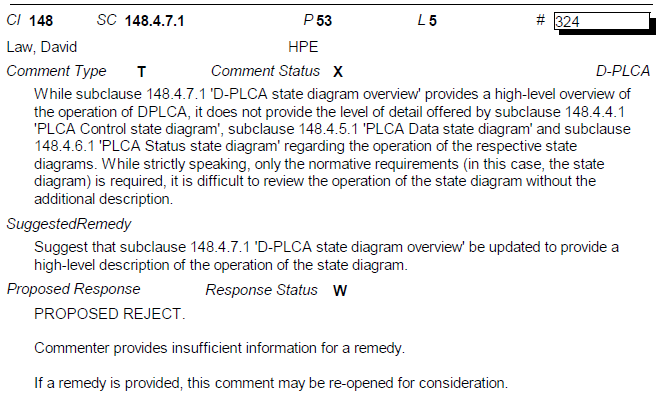Addition to the proposed text for comment #324 below.

Propose add the following text at the end of section 148.4.4.1 of IEEE 802.3-2022:
When the optional Dynamic PLCA (D-PLCA) functionality is implemented, the PLCA control function also performs the detection of hard and soft commitment of other nodes to transmit opportunities for the purpose of
identifying the availability of transmit opportunities within the PLCA cycle. Soft commits are from nodes with PLCA disabled or not implemented and is simply the reception of a packet during a transmit opportunity. Nodes that are not operating with PLCA enabled
do not have a specific transmit opportunity assigned to them.
A hard commit is indicated by a sequence of COMMIT symbols that are appended or prepended to each packet. Hard commit sequences are transmitted in the following conditions:
1) in the COMMIT state when curID becomes equal to local_nodeID while the packetPending variable is TRUE, meaning this node now owns the transmit opportunity and has a packet to transmit.
2) in the BURST state following the transmission of a packet.
Propose add the following text at the end of section 148.4.7.1 P53 L24:
When D-PLCA functionality is enabled the node switches to the WAIT_BEACON state and waits for the reception of a BEACON. If no BEACON is detected before wait_beacon_timer_done and the coordinator role is allowed,
the node promotes itself as the D-PLCA coordinator by switching to the COORDINATOR state.
The D-PLCA coordinator always maintains the plca_node_count such that transmit opportunity plca_node_count-1 is always unused. This allows new D-PLCA nodes to be added to the mixing segment by claiming this unused
transmit opportunity. Upon detecting a node perform a hard claim on this transmit opportunity, the D-PLCA coordinator will switch to the INCREASE_NODE_COUNT state and increase plca_node_count by one to create a new unused transmit opportunity.
The D-PLCA coordinator also shrinks plca_node_count to accommodate D-PLCA nodes being removed from the network. When the coordinator detects that no node has a hard claim on the last two transmit opportunities of
the cycle it will switch to the REDUCE_NODE_COUNT state. In this state the coordinator will reduce plca_node_count to the highest hard claimed transmit opportunity, plus one to maintain an unused transmit opportunity at the end of the PLCA cycle.
Detection of a BEACON or a hard claim on transmit opportunity zero by the D-PLCA coordinator indicates the existence of another coordinator on the mixing segment. In this case, the D-PLCA coordinator switches to
the LEARNING state where it demotes itself as a D-PLCA follower and begins identifying a transmit opportunity that it may claim.
Upon detection of a BEACON, new D-PLCA followers switch to the LEARNING state where they monitor the mixing segment for one PLCA cycle to identify transmit opportunities that have a hard claim. At the end of the
PLCA cycle, the D-PLCA follower will select a free transmit opportunity that does not have a hard claim. The follower will continue to monitor all transmit opportunities maintaining a table of transmit opportunities that are claimed by other followers. Once
the follower has selected a transmit opportunity, if it later detects another follower perform a hard claim on the same transmit opportunity, it will select a new transmit opportunity that does not have a hard claim.
If at any time BEACONs cease to be regularly detected and plca_status fails, followers will switch back to the WAIT_BEACON state through DISABLED.
--
Tim Baggett
Technical Staff Engineer - Applications
---------------------------------------------------------------------------------
Microchip Technology, Inc.
Automotive Information Systems
8601 Ranch Rd 2222, Park Centre, Bldg. 3, Austin, TX 78730
Office: 512-334-8450
Tim.Baggett@xxxxxxxxxxxxx
www.microchip.com
---------------------------------------------------------------------------------
To unsubscribe from the STDS-802-3-SPMD list, click the following link: https://listserv.ieee.org/cgi-bin/wa?SUBED1=STDS-802-3-SPMD&A=1